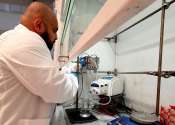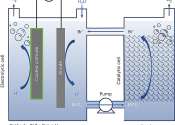Earth-abundant solar pixels found to produce hydrogen for weeks
Devices made of readily available oxide and carbon-based materials can produce clean hydrogen from water over weeks, according to new research.
Jun 7, 2022
0
623
Energy & Green Tech

Devices made of readily available oxide and carbon-based materials can produce clean hydrogen from water over weeks, according to new research.
Jun 7, 2022
0
623
Engineering

A new kind of solar panel, developed at the University of Michigan, has achieved 9% efficiency in converting water into hydrogen and oxygen—mimicking a crucial step in natural photosynthesis. Outdoors, it represents a major ...
Jan 4, 2023
2
326
Energy & Green Tech

Researchers in Sweden unveiled a new concept for producing hydrogen energy more efficiently, splitting water into oxygen and hydrogen without the dangerous risk of mixing the two gases.
Mar 6, 2024
0
231
Engineering

As important as the internal combustion engine has been for societal progress, it is also a major contributor to pollution that damages human health and carbon emissions that help drive the climate crisis. Close to 30% of ...
Aug 16, 2022
0
262
Energy & Green Tech

Hydrogen fuel cell cars emerged as an alternative to both the electric and combustion engine vehicle in the early 2000s. They were widely considered an avenue towards universal green motoring. Powered through a chemical reaction ...
Nov 30, 2022
2
145
Energy & Green Tech

A team of researchers from the Polytechnic University of Valencia and the Spanish National Research Council (CSIC) has discovered a new method that makes it possible to transform electricity into hydrogen or chemical products ...
Nov 4, 2020
3
3002
Energy & Green Tech

Stanford researchers have developed a water-based battery that could provide a cheap way to store wind or solar energy generated when the sun is shining and wind is blowing so it can be fed back into the electric grid and ...
Apr 30, 2018
2
3787
Energy & Green Tech

In 2016, experts writing in Nature listed seven breakthroughs in how we process chemicals that could change the world for the better. We believe we've just ticked one of those off the list.
Jul 15, 2022
3
238
Engineering

Umeå University researchers have made a breakthrough that may make hydrogen—a clean, CO2-free fuel—more affordable. The team has developed a new method that improves how hydrogen gas is produced from water and electricity, ...
Jun 8, 2023
1
210
Energy & Green Tech

A group of researchers from the Technion Faculty of Materials Science and Engineering has presented a new technology for producing green hydrogen using renewable energy. Their breakthrough was recently published in Nature ...
Jan 22, 2024
0
159
Hydrogen (pronounced /ˈhaɪdrədʒən/) is the chemical element with atomic number 1. It is represented by the symbol H. At standard temperature and pressure, hydrogen is a colorless, odorless, nonmetallic, tasteless, highly flammable diatomic gas with the molecular formula H2. With an atomic weight of 1.00794 u, hydrogen is the lightest element.
Hydrogen is the most abundant chemical element, constituting roughly 75% of the universe's elemental mass. Stars in the main sequence are mainly composed of hydrogen in its plasma state. Elemental hydrogen is relatively rare on Earth. Industrial production is from hydrocarbons such as methane with most being used "captively" at the production site. The two largest uses are in fossil fuel processing (e.g., hydrocracking) and ammonia production mostly for the fertilizer market. Hydrogen may be produced from water by electrolysis at substantially greater cost than production from natural gas.
The most common isotope of hydrogen is protium (name rarely used, symbol H) with a single proton and no neutrons. In ionic compounds it can take a negative charge (an anion known as a hydride and written as H−), or as a positively-charged species H+. The latter cation is written as though composed of a bare proton, but in reality, hydrogen cations in ionic compounds always occur as more complex species. Hydrogen forms compounds with most elements and is present in water and most organic compounds. It plays a particularly important role in acid-base chemistry with many reactions exchanging protons between soluble molecules. As the only neutral atom with an analytic solution to the Schrödinger equation, the study of the energetics and bonding of the hydrogen atom played a key role in the development of quantum mechanics.
Hydrogen is important in metallurgy as it can embrittle many metals, complicating the design of pipelines and storage tanks. Hydrogen is highly soluble in many rare earth and transition metals and is soluble in both nanocrystalline and amorphous metals. Hydrogen solubility in metals is influenced by local distortions or impurities in the crystal lattice.
This text uses material from Wikipedia, licensed under CC BY-SA